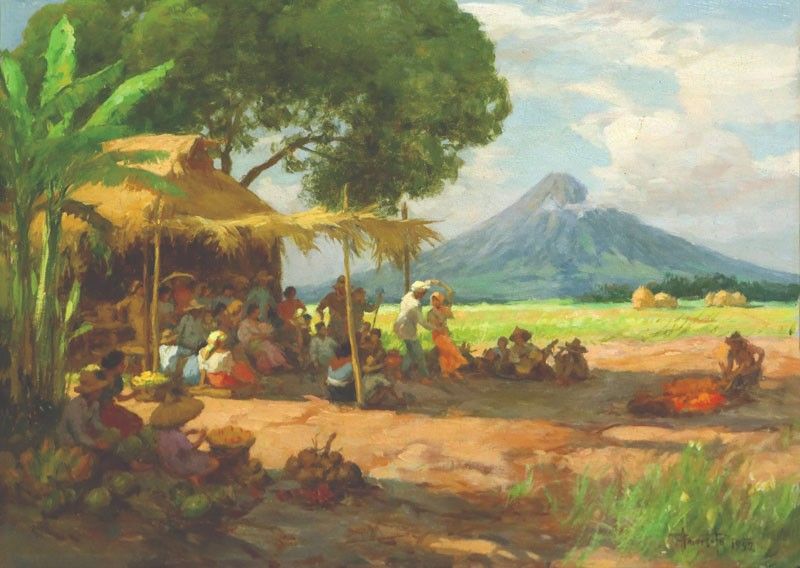Volcanoes and love in the time of the Corona virus


There’s something oddly comforting about a bit of menace in our country’s many natural wonders and nobody would be as prescient about this than the Philippines’ very first National Artist, the anointed king of Filipino landscapes, Fernando Amorsolo.
In the shadow of the recent Taal eruption, the arrival of three glorious works depicting various volcanoes by the Maestro’s own hand in the upcoming León Gallery Asian Cultural Council Auction was completely unintended. This art event is always focused on raising funds for the ACC’s many grants for Filipino artists, rather than competing with bulletins from the Phivolcs.
The first Amorsolo, “Mayon Volcano,” is a view of this once-perfect cone as it dwarfs the characters carousing at a barrio fiesta, dancing the tinikling and turning a lechon on a spit. It’s a perfect metaphor for how puny human lives are in the face of the story of our geography.
The second is titled “Mount Arayat,” surrounded by sun-streaked sky. Arayat is one of the country’s many volcanoes, now inactive after last erupting 10,000 years ago and turning into a tower of basalt. A happy couple is perched on a carabao as it trudges through a verdant field and, in the classic Amorsolo style, totally oblivious to the craggy presence in the background.
Finally, there is a mysterious work that could very well be of Taal Volcano, seen in the background across a lake. Amorsolo’s “Fishermen” are painted gathering on its banks, ready to push off into the sunrise, perhaps to make one last run at the maliputo and tawilis, that are now all but extinct because of the corrosive Taal ashfall.
For another part of the auction, Amorsolo depicts a father’s love in “Malate Church.” It was commissioned by Jose M. Ossorio, from the sugar baronetcy, to indulge his daughter’s girlish obsession with horses. (Ossorio, incidentally, was the brother of the famous abstract expressionist Alfonso.) It’s a rare painting featuring a carretela or horse-drawn carriage as it prances past the church. Ossorio’s daughter Claire Marie said that her father asked Amorsolo that it be painted in.
For Ossorio — who survived the terrors of the Liberation of Manila which we mark this February — it had an additional significance as he would remember that it was the only church standing after the 1945 bombings. The statue of Isabel II stands in the park that look outs onto Manila Bay. (The monarch’s monument was blown down by Typhoon Yoling in 1970 and was moved to the Intramuros gate named after her.)
Of course, there can be nothing more spectacular to demonstrate paternal devotion than the stunning “Dos Hermanas (Two Sisters),” a gift from Fabian de la Rosa to the journalist, educator and public servant Rafael Palma, known now to millions of millennials for having the naming rights of Palma Hall in the University of the Philippines.
Rafael would write for General Antonio Luna’s La Independencia (Independence) which became known as the official newspaper of the revolution because it was so widely read. Palma would take over as the publication’s editor after the assassination of Luna, with its printing press loaded on a railroad car to evade the American forces.
He also co-founded and wrote for the nationalist journal El Renacimiento (The Rebirth), which was openly critical of the American regime and its policies. The paper succumbed to official pressure after publishing an editorial titled “Aves de Rapiña (Birds of Prey)” in 1908 that dealt with corruption in the colonial government.
As a result, the El Renacimiento became embroiled in a libel case filed against it by the powerful Dean Conant Worcester, the then-Secretary of the Interior of the Insular Government of the Philippines. The lawsuit eventually forced the paper’s bankruptcy and closure.
Behind the scenes of this turbulent period, Palma would fall in love and marry Carolina Ocampo, daughter of El Renacimiento’s fiery publisher Martin Ocampo.
His two oldest daughters thus immortalized in this portrait are the epitomes of the Filipino feminists of the 1930s. At the time of this painting, de la Rosa was head of the UP’s School of Fine Arts in 1927; Palma, its fourth university president.
In “Dos Hermanas,” Virginia (shown on the left, born in 1903, and therefore in her late 20s at the time) is a more serious figure compared to the livelier Alicia (on the right and clearly much younger). The Palma sisters are on their way to Mass, as suggested by the long black veils that cover their heads. Alicia wears a smile and carries a delicate bead rosary in one hand. A painted Japanese paper umbrella dramatically shades their beauty.
The Palmas were characterized by historian Teodoro Agoncillo as simple folk without the airs of aristocracy nor the trappings of the nouveau riche. They were, however, secure in their intelligence and love of country; and this was expressed in their feminine but graceful baro’t saya un-gilded by the usual jewelry.
Finally, romantic love triumphs in the classic Ruora-Viola Aparador designed by the man who had the honor of rescuing Jose Rizal’s first novel from oblivion and paying for its printing, Maximo Viola. This kamagong wardrobe features the initials of his wife entwined with his in art nouveau high style, for Viola was also an artist who liked to design his own exquisite furniture, notes the antiques expert and scholar of social histories, Augusto M.R. Gonzalez III. “The affluent hacendero Dr. Viola was a good friend of Dr. Jose Rizal and it was him who lent the latter funds to publish his incendiary 1887 novel Noli Me Tangere.”
* * *
Previews for the León Gallery ACC Auction 2020 begin on Saturday, Feb. 15, till Friday, Feb. 21. The auction itself will be on Saturday, Feb. 22, all at the León Gallery sale rooms at Eurovilla I, Legazpi Village.



















